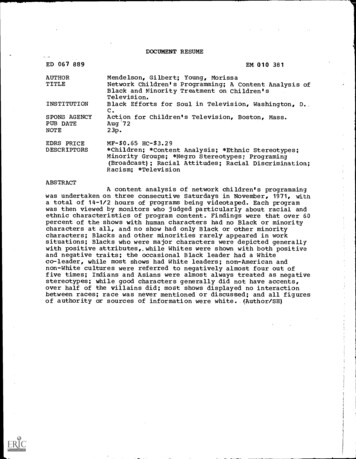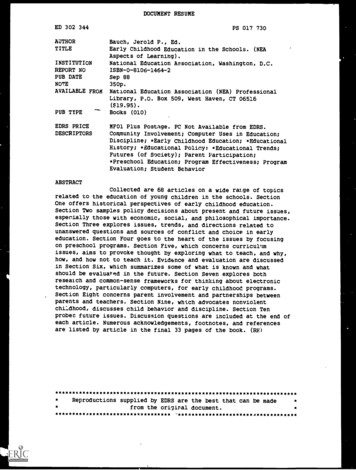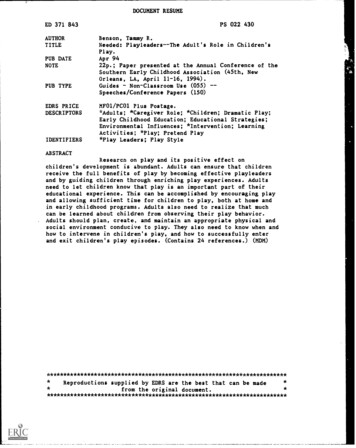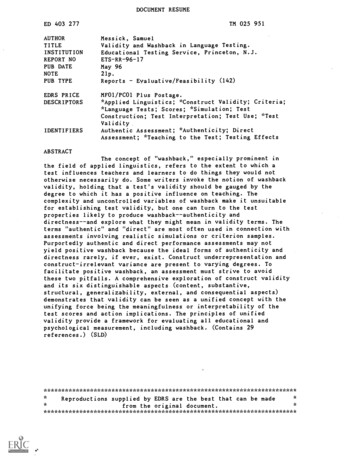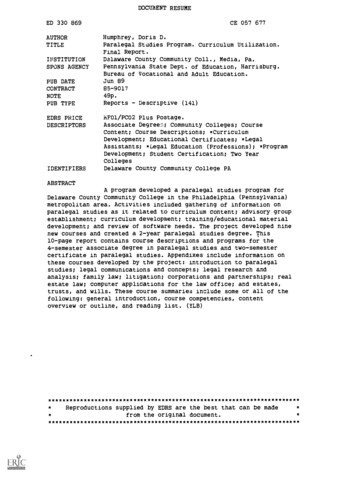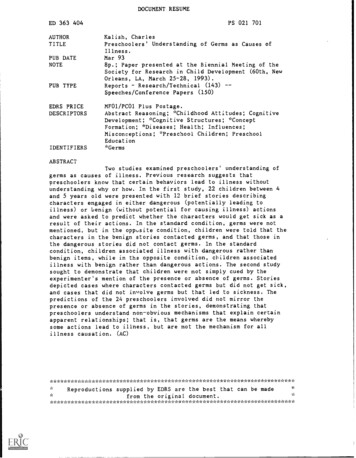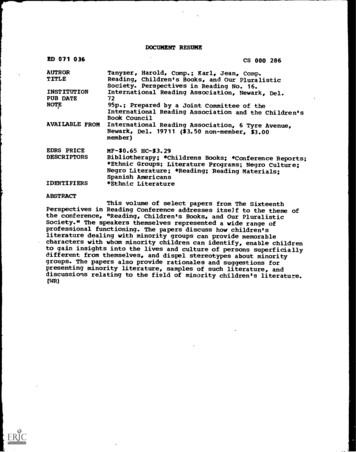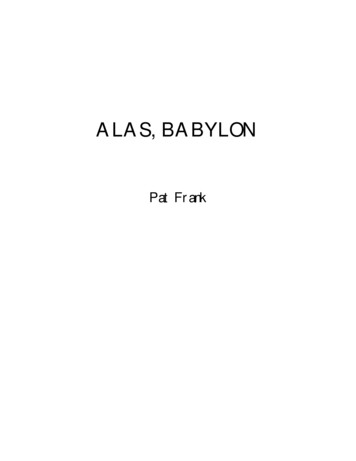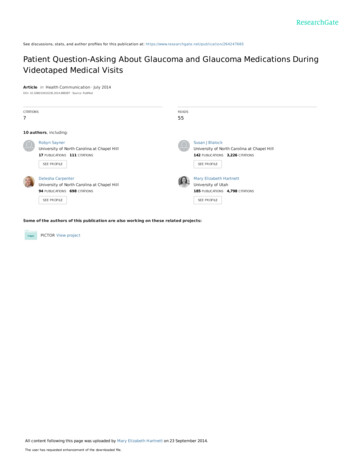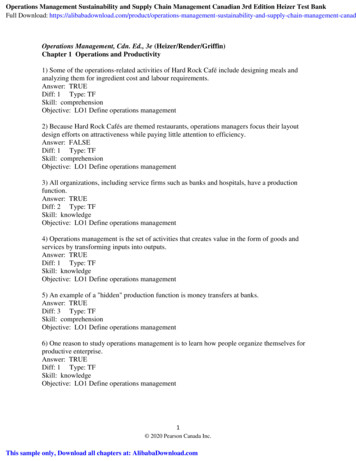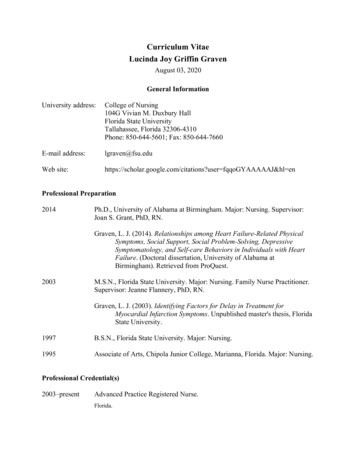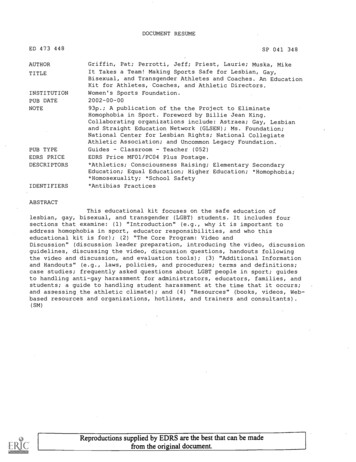
Transcription
DOCUMENT RESUMEED 473 448AUTHORTITLEINSTITUTIONPUB DATENOTEPUB TYPEEDRS PRICEDESCRIPTORSIDENTIFIERSSP 041 348Griffin, Pat; Perrotti, Jeff; Priest, Laurie; Muska, MikeIt Takes a Team! Making Sports Safe for Lesbian, Gay,Bisexual, and Transgender Athletes and Coaches. An EducationKit for Athletes, Coaches, and Athletic Directors.Women's Sports Foundation.2002-00-0093p.; A publication of the the Project to EliminateHomophobia in Sport. Foreword by Billie Jean King.Collaborating organizations include: Astraea; Gay, Lesbianand Straight Education Network (GLSEN); Ms. Foundation;National Center for Lesbian Rights; National CollegiateAthletic Association; and Uncommon Legacy Foundation.GuidesClassroomTeacher (052)EDRS Price MF01/PC04 Plus Postage.*Athletics; Consciousness Raising; Elementary SecondaryEducation; Equal Education; Higher Education; *Homophobia;*Homosexuality; *School Safety*Antibias PracticesABSTRACTThis educational kit focuses on the safe education oflesbian, gay, bisexual, and transgender (LGBT) students. It includes foursections that examine: (1) "Introduction" (e.g., why it is important toaddress homophobia in sport, educator responsibilities, and who thiseducational kit is for); (2) "The Core Program: Video andDiscussion" (discussion leader preparation, introducing the video, discussionguidelines, discussing the video, discussion questions, handouts followingthe video and discussion, and evaluation tools); (3) "Additional Informationand Handouts" (e.g., laws, policies, and procedures; terms and definitions;case studies; frequently asked questions about LGBT people in sport; guidesto handling anti-gay harassment for administrators, educators, families, andstudents; a guide to handling student harassment at the time that it occurs;and assessing the athletic climate); and (4) "Resources" (books, videos, Webbased resource's and organizations, hotlines, and trainers and consultants).(SM)Reproductions supplied by EDRS are the best that can be madefrom the original document.
IT TAKES A TEAM!MAKING SPORTS SAFEFOR LESBIAN, GAY, BISEXUAL, AND TRANSGENDERATHLETES AND COACHESAn Education KitFor Athletes, Coaches, and Athletic DirectorsWritten byPat Griffin, Jeff Perrotti, Laurie Priest, Mike MuskaEdited byDonna Lopiano, Marjorie Snyder, Lisa D. ThompsonForeword byBillie Jean KingA publication of theProject to Eliminate Homophobia in Sport Collaborating OrganizationsAstraeaGay, Lesbian and Straight Education Network (GLSEN)Ms. FoundationNational Center for Lesbian RightsNational Collegiate Athletic AssociationUncommon Legacy FoundationWomen's Sports Foundation Women's Sports Foundation , 2002ObU.S. DEPARTMENT OF EDUCATIONPERMISSION TO REPRODUCE ANDDISSEMINATE THIS MATERIAL HASBEEN GRANTED BY.)V)Prot ersTO THE EDUCATIONAL RESOURCESINFORMATION CENTER (ERIC)Ottice of Educational Research and ImprovementEDUCATIONAL RESOURCES INFORMATIONCENTER (ERIC)This document has been reproduced asreceived from the person or organizationoriginating it.Minor changes have been made toimprove reproduction quality.Points of view or opinions stated in thisdocument do not necessarily representofficial OERI position or policy.BEST COPY AVAILABLE2
IT TAKES A TEAM!MAKING SPORTS SAFEFOR LESBIAN, GAY, BISEXUAL, AND TRANSGENDER ATHLETESTABLE OF CONTENTSPageTable of ContentsiAcknowledgmentsiiiForeword by Billie Jean KingvI.INTRODUCTIONWhy It Is Important to Address Homophobia in SportResponsibilities of EducatorsBenefits of Addressing Homophobia in SportWho This Educational Kit Is ForKit Contents11233II. THE CORE PROGRAM: VIDEO AND DISCUSSIONDiscussion Leader PreparationIntroducing the VideoDiscussion GuidelinesDiscussing the VideoDiscussion QuestionsGeneral Questions for All AudiencesGeneral Questions about the VideoGeneral Questions about LGBT Issues in AthleticsGeneral Questions about Your SchoolAudience Specific Action QuestionsAction Questions for AthletesAction Questions for CoachesAction Questions for Athletic DirectorsAction Questions for ParentsHandouts Following the Video and DiscussionParticipant Reactions to the Video and DiscussionAction Guide for AthletesAction Guide for CoachesAction Guide for Athletic DirectorsAction Guide for Parentsi35677101215182021232526272830
Evaluation ToolsPost-Program Survey for Coaches/Administrators31III. ADDITIONAL INFORMATION AND HANDOUTSLaws, Policies, and ProceduresTerms and Definitions: Sexual Orientation and Gender IdentityFrequently Asked Questions about LGBT People in SportThe Safe Zone ProgramCase StudiesAn Administrator's Guide to Handling Anti-Gay HarassmentAn Educator's Guide to Intervening in Anti-Gay HarassmentA Family's Guide to Handling Anti-Gay HarassmentA Student's Guide to Surviving Anti-Gay Harassment and Physical or Sexual AssaultRights of Lesbian, Gay, Bisexual, and Transgender AthletesStudents: What to Do If You See a Student Being HarassedStaff: How to Handle Harassment in the Hallways in 3 MinutesAssessing the Athletic Climate for LGBT Athletes and Coaches33404347486366697273747576IV. RESOURCESBooksVideosWeb Based Resources and OrganizationsHotlinesTrainers and Consultants7981828485ii4
ACKNOWLEDGMENTSFirst, we'd like to thank Zina Garrison and Don McPherson who generously donated their timeand talent to narrate the video. A special thank you to Zina Garrison for arranging for the USTAto provide space and staff support to tape the narration during the 2002 U.S. Open. Thanks goto Yolanda L. Jackson as talent liaison for making the arrangements with the USTA to providespace and for assisting Zina and Don during the taping of the narration. Special thanks also tostaff at the USTA: Michelle Martinez for arranging logistics and Alex Palombo for handlingcredentials and to Mary Faye and Harold Prather, Jr., for all of their assistance prior to andduring the shoot. Thanks to Mary Faye, we also have Robin Watson to thank, who, at amoment's notice, provided make-up for the shoot. Great work done by all!We want to thank Dan Nocera, Corporate Media Producer, for contributing his great work andtremendous talent as a videographer and editor producing the "It Takes a Team!" video, andspecial thanks also to his production assistant, Jeannie Newman. Thank you Keith Larsen, fromBroadcast Communications Center, for lighting assistance. Thanks also to MiddlesexCommunity College students Kelly Colonghi, for production assistance, and Tim Fromme,Wilbur Glenn, Frank Moshier, Kris Ruffino, Carrie Stu la for post-production assistance.Thank you to Donna Lopiano, Rosie Stallman and Lisa D. Thompson for identifying and locatingathletes and arranging for interviews for the video. Thank you to Marjorie Snyder, forinterviewing Lauren Ruffin. Thank you to Lisa D. Thompson for interviewing Jaime Bailey, DanBozzuto and Lauren Ruffin for the video. Many thanks go to Ellen Landis, as CreativeConsultant throughout the Project, as well as for production assistance during the interviewswith Jaime Bailey and Dan Bozzuto and the narration with Don McPherson and Zina Garrison.Special thanks go to Bob Akamian, Producer/Announcer with Action Sports Cable NetworkTelevision, Portland, Ore., who interviewed Andy Holder for us. Thanks also to PeggyMelanson, Producer, and Karl Nazir, Programming Coordinator, with Somerville CommunityAccess Television, Somerville, Mass., for technical assistance with the Mike Crosby interview.The video used many clips produced by others, for which we express our appreciation for theright to repurpose such wonderful work: Dee Mosbacher of Woman Vision, San Francisco,Calif., for use of clips in her National Educational Media Network Apple Award-winning film "Outfor A Change: Addressing Homophobia in Women's Sports." ABC News, New York, N.Y., forthe clips from "The Corey Johnson Story," and Jeff Perrotti, Somerville, Mass., for clips ofinterviews he conducted with and footage he shot of Corey Johnson and Mike Crosby. KeithPelley, President of The Sports Network, Canadian Television and David Mcllvride and AikenScherberger, Producers, Television Renaissance, Toronto, Canada, for use of clips from theGemini Award-winning video "For The Love of the Game."The video used in this kit would not have happened without the enthusiastic cooperation of thesubjects depicted: athletes Jaime L. Bailey, Dan Bozzuto, Mike Crosby, Andy Holder, CoreyJohnson, Nicole LaViolette, Susan Mullaney, Lauren Perrotti, and Lauren Ruffin. We also wantto thank Corey Johnson's teammates Joe Bavaro, Thomas Bennett, Chris Romero, and JimWhalen; his coach, Mike Cerullo; and his mother, Ann Richardson. Thanks also to Judy BourellMiller and Bob Miller. We thank them all for sharing their experiences.Special thanks go to the Project's Writing Committee who worked so diligently on developingthis extraordinary educational resource: Pat Griffin, Mike Muska, Jeff Perrotti, Laurie Priest andMarjorie Snyder. We are grateful to Lisa D. Thompson, the Project Director, who put this alltogether.iii
The poster concept was conceived by Writing Committee members: Pat Griffin, Jeff Perrotti andLaurie Priest inspired by the artwork of Rob Ranney and Kathy Neal with the creative input ofEllen Landis. The poster creation was shepherded by Marj Snyder with the poster art createdand contributed by Emily Oinen and poster design by Deana A.G. Monahan.We also want to acknowledge Tuti Scott for fundraising for the Project, as none of this would bepossible without the funds to support the mission of the project to Eliminate Homophobia inSport.We would like to express our gratitude to the organizations and individual donors responsible forthe establishment of an education endowment at the Women's Sports Foundation that resultedin the establishment of the Project to Eliminate Homophobia in Sport, especially MartinaNavratilova, who participated in major fundraising initiatives, and an anonymous philanthropistwhose vision is expressed in the development of the Project. We would like to thank those in theearly stages of the Project's inception for their generous contribution of time and expertise.Special thanks to Helen Carroll for her contribution as Project Director in phase one of theProject to Eliminate Homophobia in Sport and to the initial Writing Group members BeverlyBaker, Mariah Burton Nelson, Pat Griffin, Leslie Heywood, Jane Meyer, Mike Muska, JeffPerrotti, Laurie Priest, Marjorie Snyder, and Reactor Group Steve Baker, Joanne Fortunato,Marcia Greenberger, Betty Jaynes, Kate Kendell, Richard Lapchick, Robert Lipsyte, JaneMeyer, Dee Mosbacher, and Don Sabo.Last but not least, we applaud the organizations represented by the Steering Committee, whosefunding and commitment to diversity in education are providing the leadership that will makeathletics a safer place for all student-athletes.Steering CommitteeProject to Eliminate Homophobia in SportAstraeaKatherine AceySandra RobinsonGay, Lesbian and Straight Education NetworkKevin JenningsScott HirschfeldMs. FoundationMarie WilsonNational Collegiate Athletic AssociationRosie StallmanNational Center for Lesbian RightsKate KendellHelen CarrollUncommon Legacy FoundationKim HooverReed BogleWomen's Sports FoundationDonna Lopianoiv6
FOREWORDWe all know, deep down, that successful teams are most oftenthose who are dominated by coaches and athletes who understandthe relationship of respect to the realization of our abilities. Whencoaches are respected, players learn. When players are respected,they learn, improve, and flourish. The bottom line for those whodeliver this educational program is the creation of educationalenvironments in which respect is the dominant value.The locker rooms and playing fields of sport are laboratories inwhich we develop and practice values. Every practice and everygame presents the opportunity to make ethical choices, from theadherence to the letter and spirit of rules to the way we treatteammates and opponents. By including sport as an importantextracurricular activity in our educational institutions, we acknowledge the important possibilitiesof its use as a value laboratory.What we love most about being coaches is when we use this environment to give young peoplethe gifts of confidence and self-esteem and see our teams win and lose gracefully and withintegrity. There is nothing like the feeling of being challenged by the finest opponent under thestress of competition and leading young people to play and act better than they ever havebefore to see them leave the playing feel, win or lose, knowing they were really good! This iswhy we are in our profession. This is what gives me goose bumps!We are all different, from the color of our skins to the pitch of our voices, from our religions andethnicities to our sexual orientations and the sizes, shapes, and abilities of our bodies. Wedeserve to be judged by the things that really count honesty, integrity, the effort we put forth inpractice and during the game, the way we treat others, and how we help those who are not asfortunate. As educators, we understand the importance of celebrating such diversity and givingour best effort to every student, without bias.Too often sport has not come under the standard of scrutiny applied to attitudes and behavior inthe classroom. How frequently does the locker room ring with misogyny or homophobia;statements like "You are playing like a bunch of girls" or "They're all dykes"? How many timeshave players and coaches been heard saying, "Get that faggot" or "There are no lesbianspermitted on this team." How many good young people have been hurt by being forced to denywho they are because of the prejudice and discrimination of others. If these words andbehaviors continue, we will have generations of coaches and athletes who perpetuate prejudiceand disrespect.The relevance of seeking equality and fair treatment of all persons as a basic right in sport andother parts of their lives is both real and deliberate for all the organizations and individuals whouse this education kit. I applaud your commitment to diversity, inclusiveness, and creating moresafe and rewarding environments for our student-athletes, coaches, and administrators.I am particularly grateful to those who worked on this project and the individuals, foundations,and organizations whose financial gifts made it possible. You are to be commended for yourleadership.-- Billie Jean Kingv
BILLIE JEAN KINGBillie Jean King was named one of the 20th century's "100 Most Important Americans" by Lifemagazine in 1990. She founded the Women's Sports Foundation in 1974 and is the chair of theFoundation's Board of Trustees.During her playing career, she won 71 singles and 21 doubles titles, including a record 20Wimbledon titles. She remains one of the most illustrious players in tennis history. She achievedthe world's highest ranking five times between 1966 and 1972 and held a place in the top 10 for atotal of 17 years. In 1973, she defeated Bobby Riggs in straight sets to win the landmark "Battleof the Sexes" match. Retired from the sport in 1983, King remains one of only eight players tohave won a singles title in each of the four Grand Slam tournaments.In 2002, she was awarded the International Olympic Committee's highest women's sports honor,the International Olympic Committee Women and Sport Trophy. In 1999, King received theArthur Ashe Award for Courage in recognition of her work for social change and also became thefirst woman to be given the NFL Players Association Lifetime Achievement Award. In 1998, shewas the first athlete to be awarded with the Elizabeth Blackwell Award. In 1997, she received theWomen's Sports Foundation's Flo Hyman Award. She was honored with the March of DimesLifetime Achievement Award for her commitment to helping others in 1994. She was inducted intothe National Women's Hall of Fame (1990), the International Tennis Hall of Fame (1987) and theInternational Women's Sports Hall of Fame (1980). She was the first woman to be named SportsIllustrated Sportsperson of the Year in 1972.King coached the Olympic gold medal-winning 1996 and 2000 U.S. women's tennis teams andcaptained the U.S. Federation Cup team from 1995 to 1996 and from 1998 to 2000, leading theUnited States to the title in 1999. She co-founded WORLD TEAMTENNIS and Women's SportsLegends. King also has worked extensively as a commentator on ABC, CBS, CTV, HBO, andNBC. A founder of the Women's Tennis Association in 1973, King was its first president from1973 to 1975, and again from 1980 to 1981.In order to promote equality of life and opportunity for all, she set up the Billie Jean KingFoundation in 1998 and remains on its board of trustees. She lends charitable support to the fightagainst AIDS, acting as a director of both the Elton John AIDS Foundation and the National AIDSFund.vi
INTRODUCTIONWhy It Is Important to Address Homophobia in SportHomophobia affects all males and females regardless of their sexual orientations or genderidentities. Fear and lack of understanding about different sexual orientations and genderidentities lead to harassment, discomfort, isolation, and violence. These behaviors andfeelings create unsafe environments that hinder learning, damage friendships, and hurtteams as well as individual athletes and coaches. For example: The male locker room hasoften been criticized as a place where sexist and homophobic behavior is commonplace,girls and women in sport are often called "lesbian" in an attempt to discredit and discouragetheir athleticism, and lesbian, gay, bisexual, and transgender (LGBT) athletes and coachesare the targets of harassment and discrimination. This educational kit is based on the beliefthat all athletes and coaches have the right to expect:Safety from physical or verbal harassment or violenceFair Treatment in all aspects of programmingEqual Access to all aspects of programmingSupport for developing positive self-esteem and acceptance of othersEducation about social diversity, prejudice, and discriminationResponsibilities of Educatorsa.Safe Learning Environment. All schools and sport organizations include lesbian, gay,and bisexual (LGBT) students, staff, and parents even if they have not made themselvesknown to the school or community. Educational institutions, athletic departments, andsport organizations have a responsibility to make their programs safe for all athletes andcoaches, including LGBT athletes and coaches.b.Respect for Difference. Coaches are important role models in athletes' lives. Coachesare responsible for and have opportunities to teach more than athletic skills andstrategies. They are also responsible for and have opportunities to set examples ofrespect for differences.c.Legal Liability.More LGBT athletes and coaches are successfully using legalresources to address discrimination and harassment when administrators and coachesfail to address these issues. Educators have a responsibility to make sure their actionsand words do not put themselves or their educational institutions in a position of legalliability.d. Community Leadership. Student-athletes and coaches are highly visible communitymembers who can influence how safe and welcoming schools and sport organizationsare to students and student-athletes who feel marginalized.e.Removing Fear and Ignorance.Allathletes have LGBT teachers, coaches,teammates, friends, or family members in their lives and LGBT people are increasinglyvisible. Young people need an opportunity to develop attitudes and beliefs based onrespect for differences rather than fear or ignorance.19
Benefits of Addressing Homophobia in Sporta.Improve Team and Coach Performance. Interpersonal tensions among teammatesrelated to homophobia and acts of discrimination or harassment directed at LGBTpeople in athletics often have a negative effect on team performance as well as teamunity. LGBT athletes and coaches perform best when they are treated with respect andaccepted for who they are.b.Decrease Suicide Rates. A 1989 U.S. Department of Health and Human Servicesstudy reported that up to 30% of suicides among young people are lesbian and gayyouth who are so isolated and depressed in the face of societal and peer condemnationthat they kill themselves. College and high school coaches and sport organizations areworking with this age group and have an opportunity to reduce such incidences.c.Decrease the Incidence of Hate Crimes and Harassment. Statistics show that highschool aged young men, often acting in groups, commit hate crimes and harassmentdirected at many minority groups, including lesbian and gay people.d. Challenge Destructive Stereotypes. When LGBT coaches or athletes do not feel safeenough to disclose their identities, other athletes and coaches, in the absence ofaccurate information, believe that destructive stereotypes of LGBT people are true.e. Reduce Fear, Ignorance, and Discrimination. Naming LGBT athletes and coaches as"the problem," rather than homophobia, perpetuates ignorance, fear, and discrimination.f.Create Safe Environments. In a hostile athletic environment, LGBT athletes learn tofeel shame and self-hatred and hide their identities at great psychological cost. Creatingsafe environment improves the psychological well-being of LGBT and heterosexualathletes.g.Improve Team Chemistry and Learning Environment. When homophobia is notaddressed, heterosexual young people are defensive and fearful because theirprejudices about LGBT people are unchallenged. Homophobia encourages athletes tofear association with gay, lesbian, bisexual, transgender teammates or coaches.Reducing defensiveness and fear improves team chemistry and relationships andimproves the teaching environment.h. Remove Athletic Participation Barrier. Many heterosexual young people are afraid ofbeing perceived as LGBT. As a result, they may restrict extracurricular interests, careerchoices, and friendships. Many women do not choose to participate in sport becausethey fear being called lesbians. Removing this barrier to participation increases thelikelihood of more students being involved in sport.i.Redefine Masculinity. Homophobia encourages men and boys to deny feelings andinterests inconsistent with traditional conceptions of masculinity. Rigid conformity tomasculine stereotypes may be harmful to their full psychological and socialdevelopment.Make Sport a Safe Place for Future Generations. Unless coaches and athleticdirectors take action against homophobia, the next generation of young coaches andathletes will inherit the same prejudices of previous generations of coaches and athletes.2I0
Who This Educational Kit Is ForThis educational kit includes a variety of resources for anyone interested in making athleticssafe for everyone, including LGBT athletes and coaches.We hope that coaches,administrators, teachers, athletes, parents, or others who care about fairness and safety insport will find this educational kit helpful in raising awareness and taking actions to makeathletics safe for all. This educational kit can be used in a variety of settings with differentgroups:At regional or national professional conferences or meetings with coaches andadministrators or other athletic staffAs part of a new school year orientation program for new coaches, athletes, or parentsAs part of athlete educational programmingAs part of administrator staff development programming in school districts and othereducational institutionsAs part of coaching staff development programsAs a part of diversity training for use in athletic team meetingsAt a diversity training for parent-teacher/coach meetingsAs part of coach or administrator education program or classAs part of sport studies curricula addressing social issues in sportIdeally, every athletic department should have an educational kit for use by athletic directorsduring staff orientation or other professional development programs for coaches or for useby coaches in programs they lead with athletes.Kit ContentsVideoIt Takes A Team! Making Sports Safe for Lesbian and GayAthletesDiscussion GuidesDiscussion guides are provided with questions for leaders to useto lead discussions about the video with four groups critical toshaping the athletics environment: (1) athletic directors andeducational administrators, (2) coaches, (3) athletes, and (4)parents. The kit contains information the discussion leader canuse to deliver an initial video session as well as follow-upmeetings to address questions not addressed in the first session.Reproducible Handouts Selected resources appropriate as handouts to supplement orprepare audiences for the video program. NOTE: Permission hasbeen obtained from all copyright holders for kit users to reproduceand distribute these materials in keeping with the purpose of thisprogram.ResourcesA list of resources on addressing LGBT issues in sport, including aWeb site where all of the materials in this kit except the video andposter are available at no cost.311
PostersFour copies of a poster that can be displayed in locker rooms,offices, classrooms, or hallways. The poster is printed on the frontand back so that both sides can be read when posted on glasswalls or windows. If these surfaces are not available, multiplecopies are provided so that both sides can be displayed"Safe Space" Stickers A "LGBT Safe Space" sticker is included in the kit with instructionsfor ordering more. This is a nationally recognized programdescribed in Section Three of this kit (see Table of Contents).Additional stickers may be obtained from: Donnelly and Colt.P.O. Box 188, 202 Station Road, Hampton, CT, 06247-0188, 860455 -9621.Kit EvaluationYour evaluation of this educational resource would be greatlyappreciated. Please fill out the "It Takes A Team! Post-ProgramSurvey for Coaches/Administrators" and return it in the businessreply envelope provided.4
THE CORE PROGRAM: VIDEO AND DISCUSSIONDiscussion Leader PreparationPreview the Video. The gay or lesbian athletes and their teammates and coaches in this videodescribe some of their experiences. The video describes some of the challenges that gay,lesbian, bisexual, and transgender athletes and coaches encounter and shows how it takes ateam to make sure that all coaches and athletes are safe and respected. Preview the videobefore showing it or leading a discussion about the video.Read Basic Materials. Discussion leaders can prepare themselves in a number of ways. Werecommend reading through the following material in this kit:Terms and Definitions Related to Sexual Orientation and Gender IdentityFrequently Asked Questions and ResponsesThe Action Guides for Athletes, Coaches, Athletic Directors, and ParentsThe LGBT Issues in Athletics Case StudiesExamine Resources. Examining some of the print, video, and Web-based resources listed inthe kit is also excellent preparation for discussion leaders. This basic preparation will providediscussion leaders with more information about this topic, but it is not necessary to be an"expert" on LGBT issues to be an effective discussion leader. Other important leadershipqualities that will ensure a good discussion are a commitment to making sports safe for allathletes, effective communication skills, and rapport with the group. The discussion leader's roleis to provide an opportunity for participants to explore this topic in a productive and educationalmanner.Obtain Required Permissions. If necessary, secure all permissions to show the video. Forexample in many schools, administrative and/or parental approval is required for showingeducational videos to students or athletes. When advertising the video as part of an opencommunity event, use the title of the video and prepare potential participants for a discussion ofLGBT issues in sport. For classes and teams or other "closed" events, explain what the video isabout and why the group will be viewing and discussing it.Prepare Audiences. Preparing the audience for viewing and discussing the video is importantto ensure the most effective use of this educational tool. As part of preparing participants for thevideo and discussion, invite them to think about the topic ahead of time. For example, ask themto:Name famous LGBT athletes they know ofIndicate if they have ever had a LGBT teammate or coach (without violating anyone'sconfidentiality).Indicate if they have heard anti-gay name-calling in the locker room or in competitionsThink about how they feel about having an LGBT teammate or coachThink about what it would be like to be an LGBT person on an athletic teamThink about the differences and similarities in reactions to gay male or lesbian athletes513
Introducing the VideoThe discussion leader should introduce the video in the following or a similar manner:Example (for student and parent audiences):"We are about to view a video, It Takes A Team! Making Sports Safe for Lesbian and GayAthletes. This video focuses on gay or lesbian athletes and their teammates and coaches.It will show us some of the challenges that gay, lesbian, bisexual, and transgender athletesand coaches encounter and describe how it takes a team to make sure that all coaches andathletes are safe and respected. After the video, we will have an opportunity to talk aboutthe video and how we can make sure that our school's teams are safe for all athletes andcoaches.Example (for athletic administrator and coach audiences):Today we are going to learn more about homophobia or fear of homosexuality in sportsettings and what we can do to address this issue. We will start with a short video, and thenspend some time discussing the video. I also have materials to give you for your owninformation or for use in coach, student, and parent educational programs at yourinstitutions.If participants express discomfort about or resistance to viewing and discussing the video, invitethem to explore what it is about the topic that makes them feel this way. Acknowledge thatmany people experience discomfort when asked to think about LGBT issues. Part of the reasonfor viewing the video
Special thanks go to the Project's Writing Committee who worked so diligently on developing this extraordinary educational resource: Pat Griffin, Mike Muska, Jeff Perrotti, Laurie Priest and Marjorie Snyder. We are grateful to
